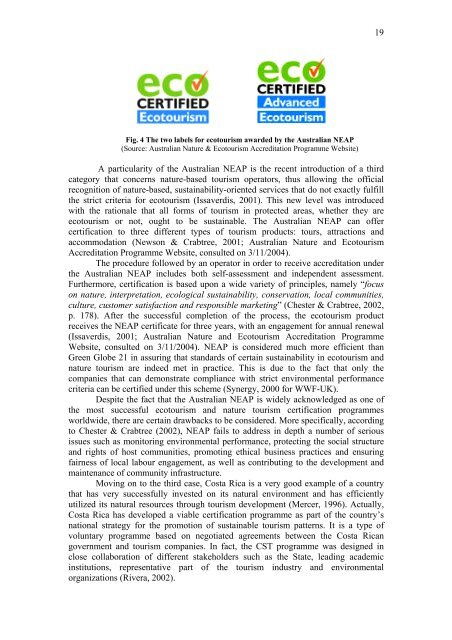Thesis title: âThe development of community-based ecotourism - lumes
Thesis title: âThe development of community-based ecotourism - lumes
Thesis title: âThe development of community-based ecotourism - lumes
You also want an ePaper? Increase the reach of your titles
YUMPU automatically turns print PDFs into web optimized ePapers that Google loves.
19Fig. 4 The two labels for <strong>ecotourism</strong> awarded by the Australian NEAP(Source: Australian Nature & Ecotourism Accreditation Programme Website)A particularity <strong>of</strong> the Australian NEAP is the recent introduction <strong>of</strong> a thirdcategory that concerns nature-<strong>based</strong> tourism operators, thus allowing the <strong>of</strong>ficialrecognition <strong>of</strong> nature-<strong>based</strong>, sustainability-oriented services that do not exactly fulfillthe strict criteria for <strong>ecotourism</strong> (Issaverdis, 2001). This new level was introducedwith the rationale that all forms <strong>of</strong> tourism in protected areas, whether they are<strong>ecotourism</strong> or not, ought to be sustainable. The Australian NEAP can <strong>of</strong>fercertification to three different types <strong>of</strong> tourism products: tours, attractions andaccommodation (Newson & Crabtree, 2001; Australian Nature and EcotourismAccreditation Programme Website, consulted on 3/11/2004).The procedure followed by an operator in order to receive accreditation underthe Australian NEAP includes both self-assessment and independent assessment.Furthermore, certification is <strong>based</strong> upon a wide variety <strong>of</strong> principles, namely “focuson nature, interpretation, ecological sustainability, conservation, local communities,culture, customer satisfaction and responsible marketing” (Chester & Crabtree, 2002,p. 178). After the successful completion <strong>of</strong> the process, the <strong>ecotourism</strong> productreceives the NEAP certificate for three years, with an engagement for annual renewal(Issaverdis, 2001; Australian Nature and Ecotourism Accreditation ProgrammeWebsite, consulted on 3/11/2004). NEAP is considered much more efficient thanGreen Globe 21 in assuring that standards <strong>of</strong> certain sustainability in <strong>ecotourism</strong> andnature tourism are indeed met in practice. This is due to the fact that only thecompanies that can demonstrate compliance with strict environmental performancecriteria can be certified under this scheme (Synergy, 2000 for WWF-UK).Despite the fact that the Australian NEAP is widely acknowledged as one <strong>of</strong>the most successful <strong>ecotourism</strong> and nature tourism certification programmesworldwide, there are certain drawbacks to be considered. More specifically, accordingto Chester & Crabtree (2002), NEAP fails to address in depth a number <strong>of</strong> seriousissues such as monitoring environmental performance, protecting the social structureand rights <strong>of</strong> host communities, promoting ethical business practices and ensuringfairness <strong>of</strong> local labour engagement, as well as contributing to the <strong>development</strong> andmaintenance <strong>of</strong> <strong>community</strong> infrastructure.Moving on to the third case, Costa Rica is a very good example <strong>of</strong> a countrythat has very successfully invested on its natural environment and has efficientlyutilized its natural resources through tourism <strong>development</strong> (Mercer, 1996). Actually,Costa Rica has developed a viable certification programme as part <strong>of</strong> the country’snational strategy for the promotion <strong>of</strong> sustainable tourism patterns. It is a type <strong>of</strong>voluntary programme <strong>based</strong> on negotiated agreements between the Costa Ricangovernment and tourism companies. In fact, the CST programme was designed inclose collaboration <strong>of</strong> different stakeholders such as the State, leading academicinstitutions, representative part <strong>of</strong> the tourism industry and environmentalorganizations (Rivera, 2002).
















